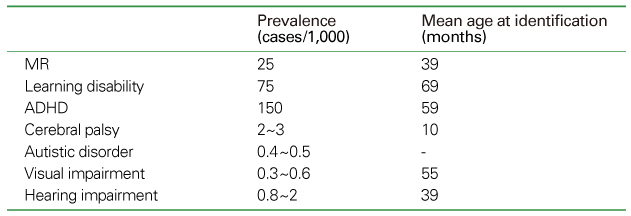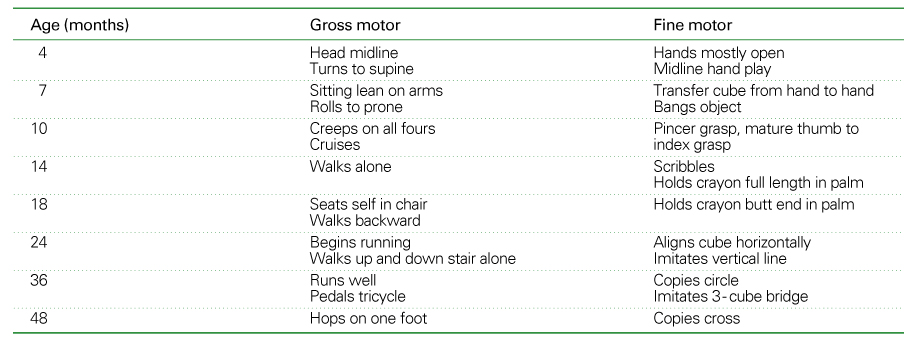 |
 |
- Search
| J Korean Med Assoc > Volume 52(3); 2009 > Article |
Abstract
Despite the relatively high prevalence (5~10%) of developmental disability, the early identification for such problems remains difficult. Doctors who care children with developmental delay tried to find out these disorders as early as possible in order to apply an early intervention and reduce the long-term disabilities among them. Identification of a delayed young child by routine out-patient's clinic mandates a careful search for an underlying etiology. This article discusses the available approaches for the infants and young children with various kinds of developmental disabilities, according to the parent's chief complaints including 'unable to walk', 'unable to speak', 'unable to control temper', and 'unable to contact his or her eyes'.
References
1. Drillen CM, Pickering RM, Drummond MB. Predictive value of screening for difficult areas of development. Dev Med Child Neurol 1988;30:294-305.
2. Simeosson RJ, Sharp MC. In: Hoekman RA, Friedman SB, Nelson NM, editor. Developmental delays. Primary Pediatric Care 1992;St Louis: Mosby-Year Book. 867-870.
3. Majnemer A, Shevell MI. Diagnostic yield of the neurologic assessment of the developmentally delayed child. J Pediatr 1995;127:193-199.
4. Shonkoff HP, Hauser-Cram P. Early intervention for disabled infants and their families: a quantitative analysis. Pediatrics 1987;80:650-658.
5. Levy SE, Hyman SL. Pediatric assessment of the child with developmental delay. Pediatr Clin North Am 1993;40:465-447.
6. Bhashin TK, Brocksen S, Avchen RN, Van Naarden Braun K. Prevalence of four developmental disabilities among children aged 8 years-Metropolitan Atlanta Developmental Disabilities Surveillance Program, 1996 and 2000. MMWR Surveill Summ 2006;55:1-9.
7. Shevell MI, Majnemer A, Rosenbaum P, Abrahamwicz M. Etiological yield of subspecialists' evaluation of young children with global developmental delay. J Pediatr 2000;136:593-598.
8. Shapiro BK. In: Capute AJ, Accardo PJ, editor. The pediatric neurodevelopmental assessment of infants and young children. Developmental Disabilities in Infancy and Childhood 1991;Baltimore Md: Paul H Brookes.
9. Illingworth RS. The Development of Infant and Young Child 1987;9th ed. Edinburgh, Scotland: Churchill Livingstone.
10. Martin TS, Forrest CB, Myles BA. Early delay in motor development. Pediatrics 2001;107:899-904.
11. Meisels SJ, Provence S. Screening and assessment: guidelines for identifying young disabled and developmentally vulnerable children and their families 1992;Washington DC: National Center for Clinical Infant Programs.
12. Shevell MI, Majnemer A, Rosenbaum P, Abrahamowicz M. Etiologic determination of childhood developmental delay. Brain Dev 2001;23:228-235.
13. Blondls TA, Roizen Nj, Snow JH, Accardo PJ. Developmental disabilities, a continuum. Clin Pediatr 1993;32:472-478.
14. Squires J, Potter L, Bricker D. The ASQ user's guide for the ages and stages questionnaires; a parent-completed, child-monitoring systems 1999;2nd ed. Baltimore: Brookes.
15. Huh KH, Squires J, Lee SY, Lee JS. K-ASQ user's manual, Korean Ages & Stages Questionnaires 2006;Seoul: Seoul Community Rehabilitation Center.
16. Glascoe FP, Byrne KE, Ashford LG, Johnson KL, Chang B, Strickland B. Accuracy of Denver-II in developmental screening. Pediatrics 1992;89:1221-1225.
17. Blasco PA. Pitfalls in developmental diagnosis. Pediatr Clin North Am 1991;38:1425-1438.
18. Shevell M, Ashwal S, Donley D, Flint J, Gingold M, Hirtz D, Mainemer A, Noetzel M, Sheth RD. Quality Standards Subcommittee of the American Academy of Neurology. Practice Parameter: Evaluation of the child with global developmental delay. Neurology 2003;60:367-380.
19. Park CI, Moon JH. In: Park ES, editor. Rehabilitation Medicine. Motor development in children and cerebral palsy 2007;Seoul: Han Mi. 535-579.
20. Surveillance of Cerebral Palsy in Europe (SCPE). Prevalence and characteristics of children with cerebral palsy in Europe. Dev Med Child Neurol 2002;44:633-640.
21. Molnar GE, Alexander MA. In: Molnar GE, editor. Pediatric Rehabilitation. Growth and development 1999;3rd Ed. Philadelphia: Hanley & Belfus, Inc.. 13-28.
22. Edwards SL, Sarwark JF. Infant and child motor development. Clin Orthop Relat Res 2005;434:33-39.
23. Sang TD, Delgado MR, Gaebler-Spira D, Hallett M, Mink JW. Task Force on Childhood Motor Disorders. Classification and definition of disorders causing hypertonia in childhood. Pediatr 2003;111:89-97.
24. Connolly KJ, Forseberg H. Neurophysiology and neuropsychology of motor development 1997;London: Mac Keith Press.
25. Capute AJ, Palmer FB, Shapiro BK, Wachtel RC, Ross A, Accardo PJ. Primitive reflex profile: A quantitation of primitive reflexes in infancy. Dev Med Child Neurol 1984;26:375-383.
26. Zafeiriou DI. Primitive reflexes and postural reactions in the neurodevelopmental examination. Pediatr Neurol 2004;31:1-8.
27. Bax M, Goldstein M, Rosenbaum P, Leviton A, Paneth N, Dan B, Jacobsson B, Damiano D. Executive Committee for the definition of cerebral palsy. Proposed definition and classification of cerebral palsy. April 2005. Dev Med Child Neurol 2005;47:571-576.
28. Bae SY. The Korean Academy of Speech-Language Pathology. Language development in Korean children. Primary materials for diagnosis. Education for Experts 1995.
29. Nelson HD, Nygren P, Walker M, Panoscha R. Screening for speech ad language delay in preschool children: systematic evidence review for the US Preventive Services Task Force. Pediatrics 2006;117:e298-e319.
30. Prathanee B, Thinkhamrop B, Dechongkit S. Specific language impairment: effect on later language development: a literature review. J Med Assoc Thai 2006;89:1775-1787.
31. Rapin Isabelle. Clinics in Developmental Medicine No.139. Preschool children with inadequate communication 1996;London: Mac Keith Press.
32. Kim SW, Shin JB, You S, Yang EJ, Lee SK, Chung HJ, Song DH. Diagnosis and clinical features of children with language delay. J Korean Acad Rehab Med 2005;29:584-590.
33. Tomblin JB, Buckwalter PR. In: Watkins R, Rice M, editor. Studies of the genetics of specific language impairment. Specific Language Impairments in Children 1994;Baltimore: Paul H Brookes. 17-34.
34. Huttenlocher J, Haight W, Bryak A, Seltzer M, Lyson T. Early vocabulary growth: relation to langage input and gender. Dev Psychol 1991;27:236-248.
35. Kim YT, Kim KH, Yoon HR, Kim WS. Sequenced Language Scale for Infants (SELSI) 2003;Seoul: Special Education Pulication Co.
36. Hong Kang E M. Korean textbook of child psychiatry 2005;Joongangcopy. 100-125.
37. Hong Kang E M. Korean textbook of child psychiatry 2005;Joongangcopy. 520-532.
38. Min SK. Modern psychiatry 2000;4th Ed. Ilchokak. 537-604.
39. Shin YJ. Childeren's behaviour 2005;1st Ed. Academya. 124-125.
40. Yoo HI, Cho IH, Yoo HJ, Koo YJ, Chung US, Ahn JS, Ahn DH, Son JW. The Korean practice parameter for the treatment of pervasive developmental disorders: Clinical manifestation, epidemiology, course, causes, and comorbidity. J Kor Acad Child Adolesc Psychiatry 2007;18:88-96.
41. Shin YJ. Childeren's behaviour 2005;1st Ed. Academya. 119-122.
42. Yoo HJ, Cho IH, Koo YJ, Yoo HI, Son JW, Chung US, Ahn JS, Ahn DH. The Korean practice parameter for the treatment of pervasive developmental disorders: Diagnosis and assessment. J Korean Acad Child Adolesc Psychiatry 2007;18:97-108.
43. American Psychiatric Association. Diagnostic and statistical manual of mental disorders 1994;4th ed. Washington DC: American Psychiatric Association.
- TOOLS









